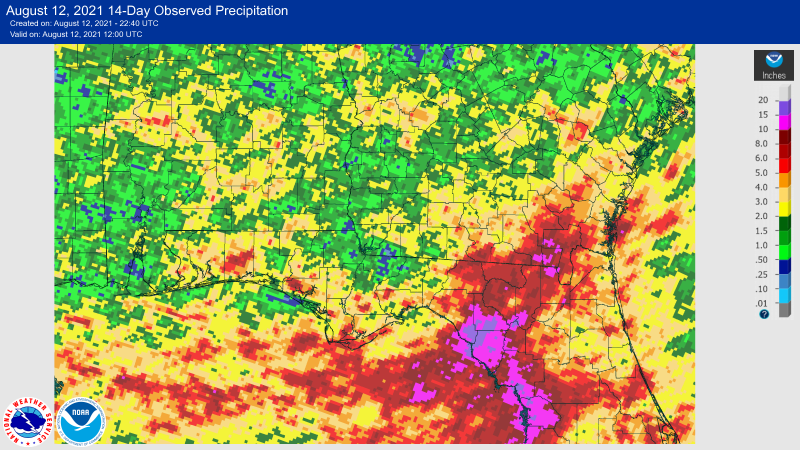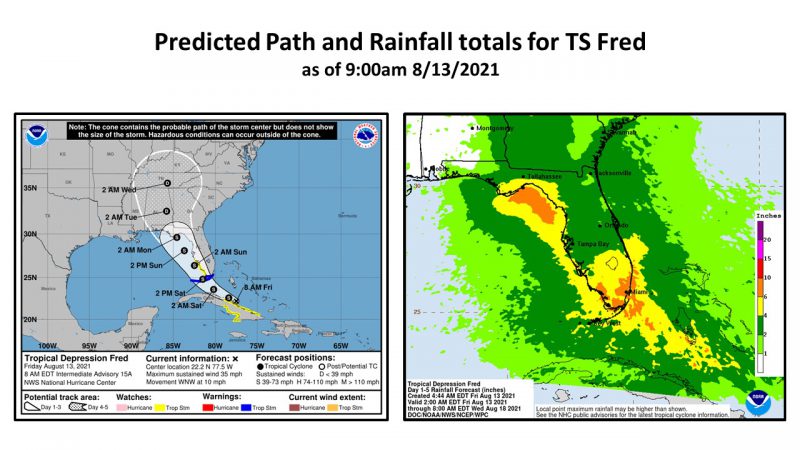Mark Mauldin, Ag & Natural Resources Agent Washington County, Dr. Barry Tillman, Peanut Breeder UF/IFAS NFREC, Ethan Carter, Regional Row Crop IPM Agent, and Camila Ichazo

The past two weeks have been fairly dry throughout the Panhandle, but quite wet towards the southern end of the peanut producing region of Florida. https://water.weather.gov/precip/
Drying conditions throughout the Panhandle have allowed field work, primarily disease management, to get back on schedule. Growers to the east have still been contending with wet fields. As of this morning (8/13/21) it appears that some portion of the peanut producing region will have to contend with abundant moisture from Tropical Storm Fred. Assuming Fred does impact the region, it will be important to get back into fields as quickly as possible to make fungicide applications (see previous updates and talk with your county’s agricultural extension agent for specific recommendations). For the time being, as we wait to see exactly where Fred will go, it is important to make timely fungicide applications as soon as possible while field conditions are still suitable.
Root worms are generally not a huge concern for peanuts in Florida’s sandy soils, but this year’s wet conditions may make them more of a concern than normal. Below is a link to a post and video that UGA’s Dr. Mark Abney put together on scouting for and managing southern corn rootworm and banded cucumber beetle.
Scouting for Rootworm in Peanut
–
aGDD Tracker for the Florida Peanut Producing Region – 8/13/21 edition
The aGDD Tracker is compiled from data generated by PeanutFARM.org. The dark blue bars in the cells with the aGDD values indicates progress towards 2500 aGDDs. The bar extends to the right as aGDDs are accumulated. The entire cell will be dark blue when a field has accumulated 2500 aGDDs. It is recommended that fields be sampled and exact days-to-harvest be determined via pod-blasting once a field reaches 2300 aGDDs.
–
The earliest planted fields on the Tracker are 147 days after planting so it is expected that some of them would have reached full maturity (appx 2500 aGDDs) and many others are getting close. The fields with the accumulated aGDD value shown in yellow have accumulated at least 2300 aGDDs and are mature enough that they should be sampled and the exact days until optimum harvest be determined via pod-blasting and a maturity profile board. Most Extension Offices will provide this service to peanut growers in their county.
If you have fields that are approaching 2300 aGDDs contact your County Extension Office and make arrangements to have samples analyzed. Over the past two weeks fields accumulated approximately 150 aGDDs each week so plan accordingly. Remember, that the information generated will only be as good as the sample provided. Collect a good representative sample; dig (don’t pull) plants from several locations throughout the field, avoiding field edges and the ends of rows. Below is a link to a document that describes the entire maturity evaluation process in detail.
Methods to Evaluate Peanut Maturity for Optimal Seed Quality and Yield
Use the Tracker to approximate how your fields are progressing by following the fields on the Tracker that are the most similar to yours in terms of planting date, location and irrigation status. For more precise tracking of your fields got to PeanutFARM.org and set up your fields in the system. You will be able to enter field specific rainfall/irrigation data and soil type. Temperature data will come from the closest FAWN weather station.
–
Upcoming UF/IFAS Peanut Field Days:
–
NFREC Marianna – August 19
–
Suwannee Valley Center – Live Oak – August 24
- Peanut Maturity Update – 10/9/25 - October 10, 2025
- Fall Can be a Great Time for Vegetation Management - October 3, 2025
- Peanut Maturity Update – 9/25/25 Edition - September 26, 2025

